The sailing of the former Varyag to be christened Shi Lang, a Qing Dynasty admiral who in 1681 conquered the Kingdom of Tungning — a territory better known today as Taiwan; reminds the author of the Gunter Grass poem
An American aircraft carrier
and a Gothic Cathedral
simultaneously sank each other
in the middle of the Pacific.
To the last
the young curate played on the organ.
Now airplanes and angels hang in the air
and have nowhere to land.
It was only about sixty five years ago, in 1942, Naval Warfare saw savage struggle for supremacy of sea control, between, the American and Japanese Navies. In the battle of Midway, in 24 hours 5 aircraft carriers, one cruiser, and a destroyer were sunk. 398 carrier borne aircraft were destroyed and 3,600 men lost their lives. This was perhaps the most decisive victory of the United States that broke the back of Japan. The probability of a similar maritime occurrence is virtually nonexistent on this scale of magnitude.
This is being highlighted here to illustrate the changing dynamics as well as the constancy of sea power in the context of application of Maritime Force in this century and perhaps the future. Technology and Strategic nuclear weapons are the game changers first and foremost. They add integral dimensions that make it virtually an all encompassing politico diplomatic military and international engagement scenario. Hiroshima and Nagasaki are still fresh in our minds too!
Sea Power however continues to be central in the comity of Nations. Perpetuation of commerce over the seas has become the overarching mission. The wisdom of Preservation of the Oceans is yet to dawn on humankind.
“Sea power is synonymous with national power. A sense of the sea, palpable, critical awareness of its catalytical connectivity potential is quintessence of this process. It has to be an integral aggregate of country’s overall economical, technological, industrial capability and strengths. This has to be woven into its vision of itself and for the present and future. Its people have to participate first and last, be passionate and committed with a sense of ownership, leadership and pride.
Aircraft Carrier Genesis
It would be interesting to note that till Shi ling appeared on the horizon, China was the lone permanent UN Security Council member which did not have an aircraft carrier. It also represents expanded Chinese national interests created by deeper integration into the global economy. In the past decade, China's trade dependence doubled from 40 percent in 2000 to 73 percent during the 2006-2008, with more than 80 percent of that trade carried by ships. The acquisition of a carrier would enable the PLA to implement Hu Jintao's 2004 "New Historic Missions" and respond to demands to undertake a range of nontraditional security operations.
A Decade More
Mastering the challenges of operating, defending, and maintaining a carrier, as well as a possible accompanying carrier task force, will take at least a decade. The PLA Navy has gone through this evolution through a patient process. The LPD as well as the hospital ship are part of this expansion programme.
SHI LANG FROM VARYAG – TRANSITION TO A REAL THREE DIMENSIONAL NAVY
 Shi Lang –outfitting in port of Dalian |
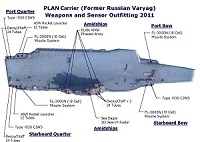 Plan Carrier Former Russian Varyag |
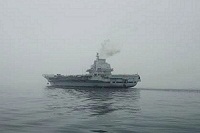 Completion of Retrofit and Trials |
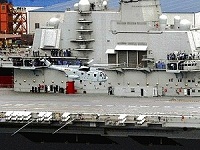 Helicopter trials on board Shi lang |
The ex-Varyag is an Admiral Kuznetsov-class aircraft carrier, measuring roughly 304.5 meters long and 37 meters wide. It was acquired at 20 million US dollars from Ukraine. The vessel has a displacement of 58,500 metric tons and can travel at speeds of 32 knots (37 miles per hour). Engines, generators and defense systems, including the Type 1030 CIWS (close-in weapon system) and the FL-3000N missile system, were added to the vessel in Dalian. As designed, it could be armed with 8 AK-630 AA (antiaircraft) guns, 8 CADS-N-1 Kashtan CIWS, 12 P-700 Granit SSM (surface-to-surface missiles), 18 8-cell 3K95 Kinzhal SAM VLS (surface-to-air missiles, vertical-launch system), and the RBU-12000 UDAV-1 ASW (antisubmarine warfare) rocket launcher. The carrier could carry 26 fixed-wing aircraft (likely the Shenyang J-15) and 24 helicopters. It is fitted with a "ski jump" ramp. It is estimated that the retrofit has cost 6 billion US dollars in exclusion of the air assets.
Front and side views of J15 the fighter aircraft for its aircraft carrier. This has been developed, moderinised and customized from the Russian SU 33
 Front view of J15 the fighter aircraft for |
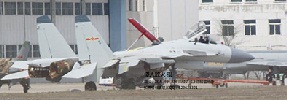 Side view of J15 the fighter aircraft |
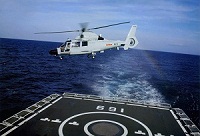 Z 9 C anti submarine helicopter |
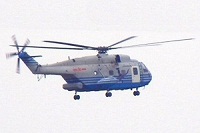 SHI LING- A FUTURE FORCE MULTIPLIER |
The Z8 Air Early Warning helicopter below made by the Chinese. The Z9 and the Z8 are off shoots from the Russian KA 28 and KA 31
Chinese Defense Ministry spokesman Geng Yansheng stated that the Shi Ling would be used for "scientific research, experiment and training. Indeed, the carrier may not be well-suited to combat, but will give China the opportunity to train sailors and pilots in aircraft carrier and other coordinated operations.
A PICTORIAL DEPICTION OF THE CARRIER EVOLUTION – UNDERSTANDING THE CHINESE MIND
To build, operate, and sustain a carrier is a challenge. The pictures below would give the reader a glimpse of the Chinese mind set in steadily building up its design, scientific, industrial and warship building capability.
Full scale mock up of the Varyag was created at Wuhan naval research facilities in 2009. This included the ski ramp, the island super structures, sensor arrays, fighter and helicopter models and deck markings.
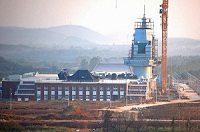 The Flight Deck |
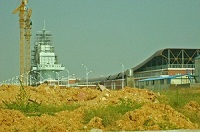 The side view of the island superstructure and mast |
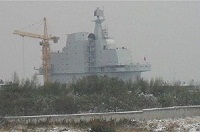 The Island and mast with all sensors |
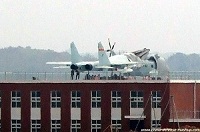 The mock up fighter and helicopter |
The Chinese Evolution of Reverse Engineering, Cloning and Experimenting has paid off rather well judging by the progress of the PLA navy from quantity to quality.
Two decades of investing in home grown, R&D, military technology industry has been the first step. Concurrently China Russia Military cooperation has quietly expanded to significant proportions across the spectrum of surface, air and even space. The Chinese military uses a fair amount of Russian systems, equipment apart from ships, aircraft and missiles. Technology transfer too has been significantly modern. A cash strapped Russia is only too willing!
An important case in point is the difference between the Chinese Varyag and India’s Gorshokov. The Shi Lang has emerged out of a Chinese port and the Vikramaditya would be sailing from Russia fully retrofitted. Comparisons of these processes in this article are irrelevant and hence unstated.
Carrier Debate for China
Shi Lang symbolizes a modest and training-focused beginning of integral aviation at sea “here and now”. It has the challenging task of getting the J 15 carrier combat conditioned and the onerous task of inducting the Z 8 Air Early warning (AEW), Z 9 Anti submarine Warfare (ASW) and perhaps a search and rescue version (SAR) too. Building up a comparable carrier escort force of destroyers, frigates, Attack Submarines would also be part of this build up.
China plans to build, 3 or 4 carriers based on its experience with Shi Lang. A strategic context of the likely pros for China on its carrier deployment is important. Carriers enable power projection capability. The obvious advantages are
a) Carriers offer a scalable set of capabilities that can handle a range of high end to low end contingencies. These would be classic naval operations, asymmetric security missions and humanitarian tasks. It would give its maritime forces long sea legs through long-range deployments. It would globally enhance China’s image as an eminent power
.
b) Proactive regional influence. The Chinese presence in the South China Sea highlighted earlier would be a force multiplier with the induction of the aircraft carrier. The carrier group would provide visible Chinese naval presence in the South China Sea, Southeast Asia, along key sea lanes in the Indian Ocean.
c) Improve China’s overall National Strategic ability to counter presence of the US and other navies not only in its waters but also in the Indian Ocean as well the East African coast line.
All this would take time, effort and money. What is clear is the direction of China’s outward wake in guarding its National interests. The down side would be the:
a) Expenditure of maintaining a viable carrier force and its escort force
b) Vulnerability of the carrier in maritime warfare given the stealth advantages of a potent enemy submarine force as well as from land based tactical missiles/shore based aircraft that have considerable reach.
Regional and Global impact of the Carrier
Shi Lang with operationalised air assets would have a wider military and diplomatic impact. Chinese carrier deployments are likely to be seen as threatening by neighboring countries like Vietnam that have competing claims in the South China Sea.
It would enable security operations against low-intensity threats like the Somali pirates. Anti-piracy missions with helicopters and embarked special-forces for boarding vessels, would be significantly enhanced with carrier-based dedicated airborne reconnaissance platforms.
The Carrier could support intensive helicopter operations serving coastal areas affected by tsunamis or earthquakes.
Chinese checkers- ABOVE, BEYOND, BENEATH, BELOW AND WITHIN THE MARITIME HORIZON
The PLA and the Chinese leadership in more ways than one symbolize the Wolf which while being upstream blames the lamb on the downstream for polluting the water. The Red dragon is building up an aura around its military power and backing it up with a stoic sense of assurance.
Perception of a declining America, a weak Europe, an impoverished Russia, a limited Japan, a diffident India, hopeless Africa, a Middle East in ruler ship turmoil and a recalcitrant Iran has encouraged the Chinese Oligarchy to see the next three decades as being opportune for consolidation of its Comprehensive National Power. Its economic prosperity can support its military expansion in all the dimensions of Space, Nuclear, Cyber, Land, Sea and Air. Its well cloistered military budget is estimated to be around 150 billion dollars in conventional arms buildup alone.
It is building a truly deep water Navy on a principle of offensive defense The PLA Navy doctrine now speaks about a strike first policy as opposed to its previous approach of wearing down the enemy. Denial of access strategy to the US Navy in the South China Sea, strengthening its string of pearls strategy in the Indian ocean, using Iran to counter American influence in the Persian Gulf and increasing its circle of influence in the Middle East, and Africa are integral to its short term plans.
The Chinese expansion is bound to have a ripple response effect in counter build up by all SE Nations, India and Japan. It would perhaps lead to a coalition of efforts led by USA Japan and India to raise the thresh hold of any Chinese aggression. Meanwhile the Shi Lang may now appear as a manatee but would become a sea dragon within the decade.
Author is Distinguished Fellow in Vivekananda Intentional Foundation
Published Date : 31st March, 2012








Post new comment